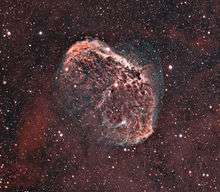Crescent Nebula
| Emission nebula | |
|---|---|
 | |
| Observation data: J2000.0 epoch | |
| Right ascension | 20h 12m 7s[1] |
| Declination | +38° 21.3′[1] |
| Distance | 5,000 ly |
| Apparent magnitude (V) | +7.4 |
| Apparent dimensions (V) | 18′ × 12′ |
| Constellation | Cygnus |
| Designations | NGC 6888,[1] Sharpless 105, Caldwell 27 |
The Crescent Nebula (also known as NGC 6888, Caldwell 27, Sharpless 105) is an emission nebula in the constellation Cygnus, about 5000 light-years away from Earth. It was discovered by Friedrich Wilhelm Herschel in 1792.[2] It is formed by the fast stellar wind from the Wolf-Rayet star WR 136 (HD 192163) colliding with and energizing the slower moving wind ejected by the star when it became a red giant around 250,000[3] to 400,000 years ago. The result of the collision is a shell and two shock waves, one moving outward and one moving inward. The inward moving shock wave heats the stellar wind to X-ray-emitting temperatures.
It is a rather faint object located about 2 degrees SW of Sadr. For most telescopes it requires a UHC or OIII filter to see. Under favorable circumstances a telescope as small as 8 cm (with filter) can see its nebulosity. Larger telescopes (20 cm or more) reveal the crescent or a Euro sign shape which makes some to call it the "Euro sign nebula".
See also
References
- 1 2 3 "SIMBAD Astronomical Database". Results for NGC 6888. Retrieved 2007-04-23.
- ↑ Erdmann, Robert. "NGC 6888". The NGC/IC Project.
- ↑ "WR 136".
External links
| Wikimedia Commons has media related to Crescent Nebula. |
- APOD (2007-11-11) – NASA Astro Picture of the Day: Image by Franck Bugnet
- NOAO image
- Chandra image
- Image by Arran Hill
- Image by Daniel Lopez
- Sharpless Catalog 105
- Crescent Nebula on WikiSky: DSS2, SDSS, GALEX, IRAS, Hydrogen α, X-Ray, Astrophoto, Sky Map, Articles and images